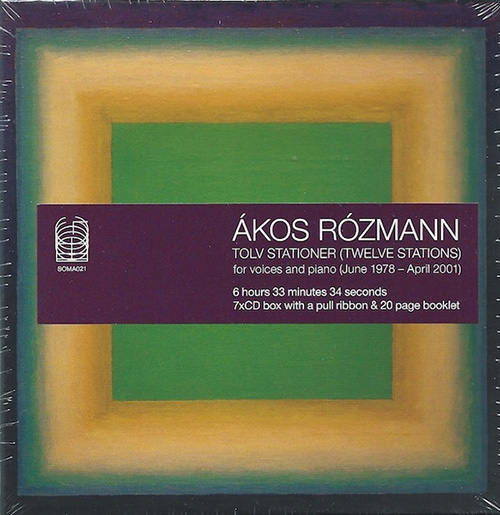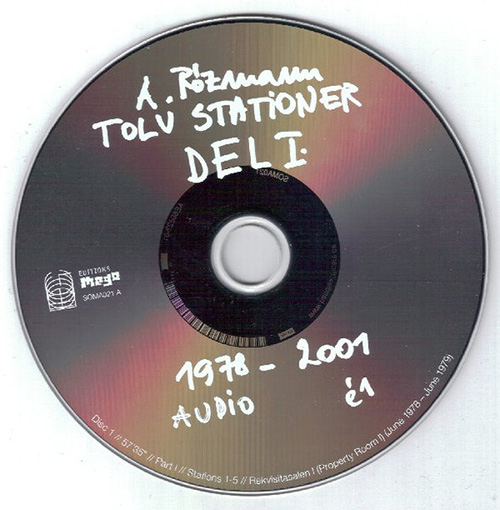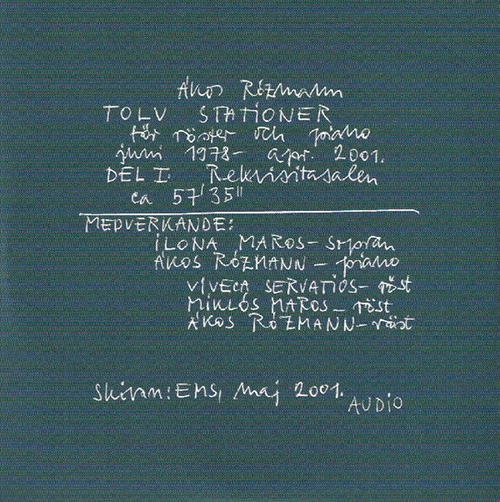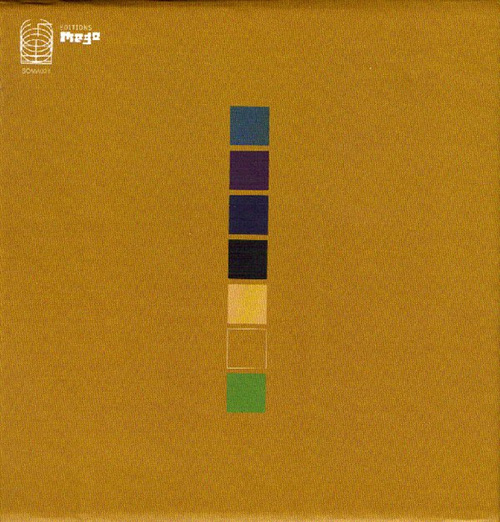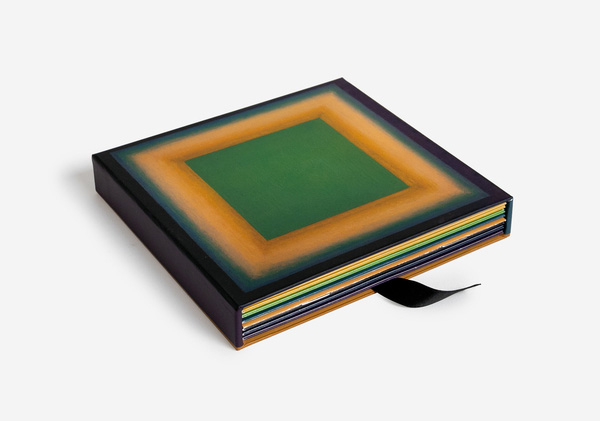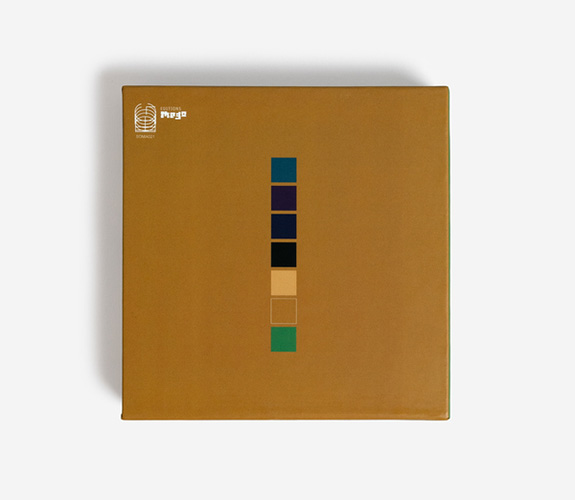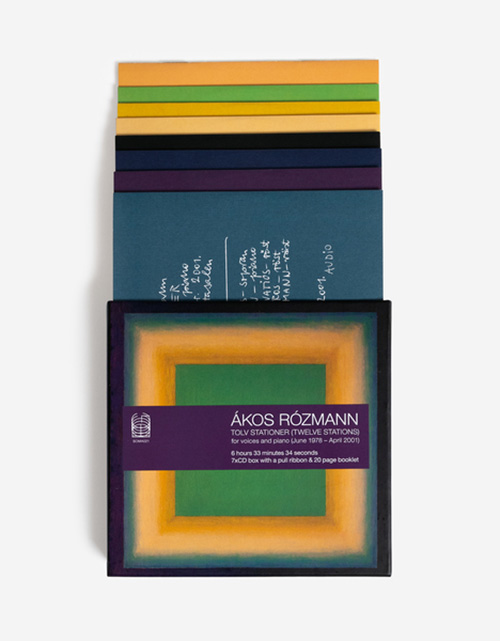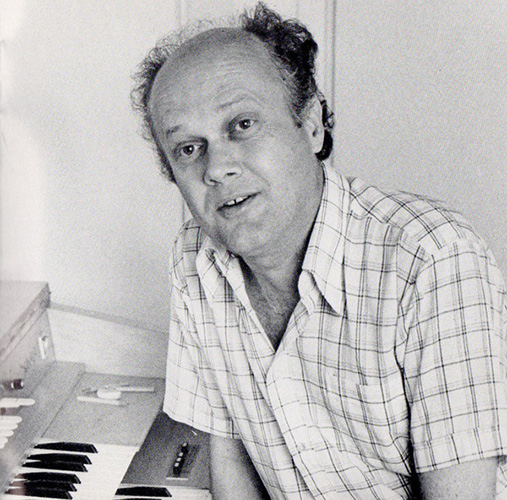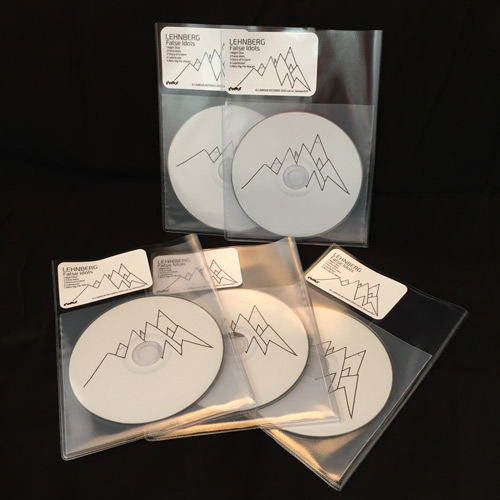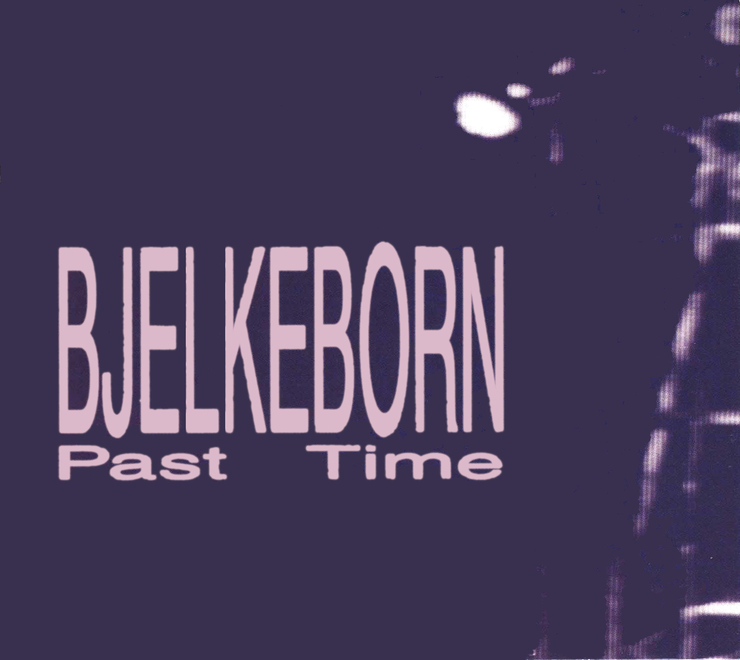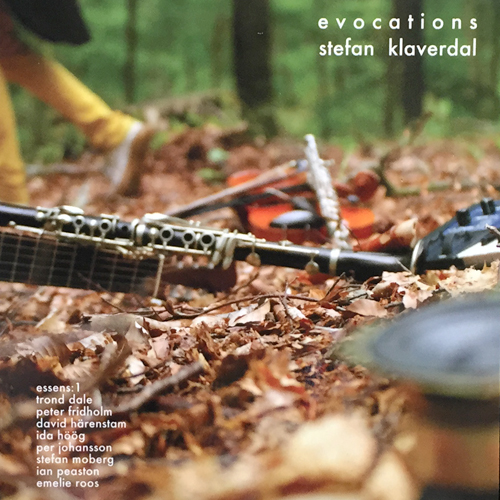Artist: Ákos Rózmann
Title: Tolv Stationer (Twelve Stations) For Voices And Piano (June 1978 – April 2001)
Format: CD-Box with 7 CD
Label: Ideologic Organ
Cat nr: SOMA021
Genre: EAM/Musique Concrète
Tracklist
| Part I Rekvisitasalen I = Part I Property Room I | |||
| 1-1 | Stations 1-5 | 57:35 | |
| Part II Rekvisitasalen II = Part II Property Room II | |||
| 2-1 | Stations 6-8 | 45:51 | |
| Part III-1 Det Svarta Hålets Innehåll Och Liv = Part III-1 The Contents And Life Of The Black Pit | |||
| 3-1 | Station 9 | 1:11:42 | |
| Part III-2 Det Svarta Hålets Innehåll Och Liv = Part III-2 The Contents And Life Of The Black Pit | |||
| 4-1 | Station 9 | 49:37 | |
| Part IV Helvetets Övergivande = Part IV The Abandonment Of Hell | |||
| 5-1 | Station 10 | 59:38 | |
| Part V Uppvaknandet = Part V The Awakening | |||
| 6-1 | Station 11 | 46:05 | |
| Part VI De Firande = Part VI The Celebrators | |||
| 7-1 | Station 12 | 1:03:06 |
- Art Direction [Ideologic Organ], Curated By [Ideologic Organ] – Stephen O’Malley
- Composed By – Ákos Rózmann
- Liner Notes [Live Performance Text] – Mats Lindström
- Liner Notes [Text Editing] – Frances Morgan
- Liner Notes [Text] – Gergely Loch
- Painting [Cover Painting], Cover [Cover Painting] – Ferenc Füzeskuti
- Performer [Contributors For The Basic Sound Material], Piano [Prepared] – Ákos Rózmann
- Performer [Contributors For The Basic Sound Material], Soprano Vocals [Soprano] – Ilona Maros
- Performer [Contributors For The Basic Sound Material], Voice – Miklós Maros, Viveca Servatius, Ákos Rózmann
- Photography By [Cover Painting Photo] – Zara Arrehed
- Photography By [Photos Of Mr. Rózmann] – Gudrun Edel-Rösnes
Composed at the studio of the Swedish Royal Collage of Music, Stockholm (parts I-II, up to station 7f); Ákos Rózmann’s private studio in the Catholic Cathedral of Stockholm (part II, station 7/g-i); Ákos Rózmann’s private studio in Skogås (part II-VI, from station 7/j to 12); Elektronmusikstudion EMS (part I-VI)
Part I // Stations 1-5: June 1978 – June 1979
Part II // Stations 6-8: July 1979 – January 1980 up to station 7/f; July – August 1984 up to station 7/i; March – May 1998 up to station 7/n and 8
Part III-1 and III-2 // Station 9: June 1998 – August 1999
Part IV // Station 10: November 1999 – March 2000
Part V // Station 11: March – July 2000
Part VI // Station 12: July – November 2000Mixing and mastering: December 2000 – April 2001
Text: Budapest, 2014
Live performance text: Stockholm, 2014
Photos Of Mr. Rózmann: 1997
On box, spine: Tolv Stationer (Twelve Stations)
On label sticker and in booklet: Tolv Stationer (Twelve Stations) for voices and piano (June 1978 – April 2001)
On CD sleeves:
Disc 1: Part I Rekvisitasalen I (Property Room I)
Disc 2: Part II Rekvisitasalen II (Property Room II)
Disc 3: Part III-1 Det svarta hålets innehåll och liv (The Contents and Life of the Black Pit)
Disc 4: Part III-2 Det svarta hålets innehåll och liv (The Contents and Life of the Black Pit)
Disc 5: Part IV Helvetets overgivande (The Abandonment of Hell)
Disc 6: Part V Uppvaknandet (The Awakening)
Disc 7: Part VI De firande (The Celebrators)
© 2014 Ideologic Organ / Editions Mego
Barcode printed on sticker affixed to the shrink wrap
On label sticker affixed to the shrink wrap:
Ákos Rózmann
Tolv Stationer (Twelve Stations)
for voices and piano (June 1978 – April 2001)
6 hours 33 minutes 34 seconds
7xCD box with a pull ribbon & 20 page booklet
CDs housed in card sleeves. The booklet contains an extensive essay on the composition by the scholar Gergely Loch, photos from the process and of scores and the composer.
_____________________________
Reinforce thy CD shelves for a new edition of Ákos Rózmann’s concrète masterpiece; a 6.5 hr predecessor and parallel to his recently issued ‘Massa’, equally generous in its hellish/heavenly scope and unfathomable depth of vision, presented in its astonishing entirety.
The term peerless, in its strictest sense, should be reserved for the likes of ’12 Stations’, an incredibly ambitious and singular work realised over the course of decades in focussed isolation by Hungarian-Swedish genius Ákos Rózmann. Beginning in 1978 as composer Miklós Maros’ commission for a five minute work for piano and vocals by his wife, Ilona Maros, the piece wouldn’t be completed until 2001, arriving in phases that ultimately spanned the progression of late c.20th experimental composition techniques, from tape-editing era to the DAWs of the early c.21st. It is a masterpiece of dematerialised sound alchemy, an utterly compelling parade of grotesqueries and epiphanies following a logic that’s never been fully disambiguated by its composer, who hints at its influences from the Tibetan Book of the Dead and the Catholic Church, but leaves a lot, and we say a lot, to the imagination.
Depending on yr tolerance for hellscapes and the inexplicable side of the human psyche, ’12 Stations’ is either a dream come true or a nightmarish experience, maybe both simultaneously. From the initial seeds of vocal and prepared piano, Rózmann cultivates a sprawling body of work that, if you step back in an attempt to grasp it whole, appears to describe an ascent from hell into heaven over its considerable narrative arc. The first two sections, completed 1978-1984, dissect and deploy the vocals as swarming apparitions or the cries of souls flayed by the flechettes of his prepared piano and scalding synth eruptions. Further in, ‘The Abandonment of Hell’ appears to initiate its ascent, allowing more space and light in the mix, illuminating its gurning voices in a half light, while there’s almost a choral musicality to the proceeding piece ‘The Awakening’.
Its final sections, completed with sampler keyboard and FX 1999-2000, feel notably more weightless in comparison, shedding chains of the arduous tape-splicing process to emerge in fluttering synth figures and choral keen of ‘The Celebrators’ and ultimately culminate in ‘The Contents and Life of the Black Pit’, with its shivering voices in streaking flux with shards of luminous synth and broken piano notes. Not once during the entire piece does Rózmann compromise his vision, never letting any element stand still or fixed, assuring a disorienting, spirit-reprogramming and life-affirming experience in the process for anyone daring to enter his portal. Best to leave you with his own words:
“Man meets different difficulties and sufferings through his wandering. These are forces between which a continuous struggle is going on. He cannot control and preside over these forces. He is being tossed up and down, powerless, like snowflakes in the storm: chaotic thoughts and feelings, gladness and suffering, which flow without intermission like a river that has no beginning nor end. All these are the fruits of our own deeds. However, in this life you have the chance to make easier those life wanderings that are to come. – Rózmann (from the programme notes for the 1984 premiere of the first seven stations).
BIOGRAPHY
Ákos Rózmann was born in 1939 in Budapest, Hungary, where he studied composition at the Bartók Conservatory and the Liszt Academy. In 1971 he received a scholarship to come to Stockholm and completed his compositional studies with Ingvar Lidholm at the Royal College of Music in Stockholm and then settled down in Sweden. He was the organist at the Catholic Cathedral in Stockholm for a long time. His early encounter with electroacoustic music gave a new direction to his composing. Except for a few early pieces, Rózmann composed solely electroacoustic music – often preferring a monumental form, usually with the organ and the human voice as the most crucial sound sources in a complex, penetrating musical language loaded with symbols. As a composer, he worked involuntary seclusion, uncompromisingly and with great originality. Rózmann’s music is about the fundamental questions of existence, often on an ethical or religious (Catholic or Buddhist) basis, for example, in the enormous suites Images of the Dream and Death and Twelve Stations, both previously released on Ideologic Organ.
Text from Boomkat

